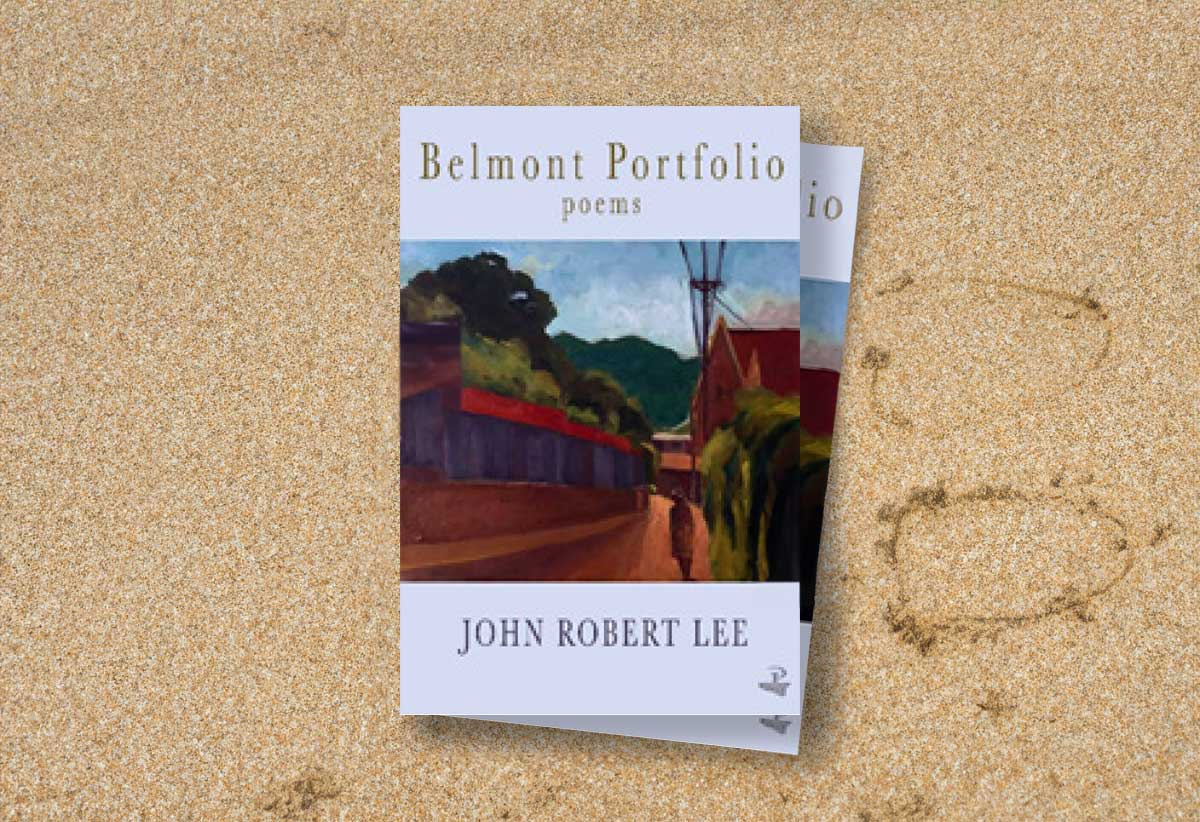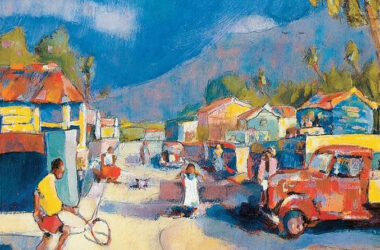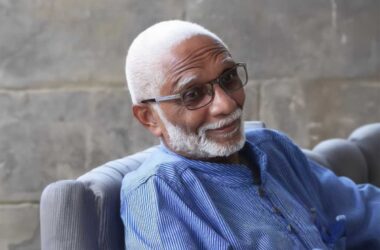
In an interview with Caribbean Writers and Poets, John Robert Lee (JRL) characterises his latest collection, Belmont Portfolio, as a companion book to his earlier Pierrot (Peepal Tree, 2020). And this is probably so thematically, imagistacaly, apt in its exploration of language use with its formal renderings. He references calypsonians and other singers he admires.
The sequence for which this book is named, dedicated to Trinidadian novelist Earl Lovelace, begins: ‘some girl you never spoke with / some girl who walked on the other side of your road / some girl you looked out for from your blue window / lived in a house like this’ (p.10). Then: ‘who will come to the red gate with the red mail tinbox / its pillars topped with red pyramids / who will walk past the yellow hydrant / and stare through the closed gate / at the thick variety of garden’ (p.11). Lee told this writer that the Belmont Portfolio cycle was inspired by photographs he took around Belmont in 2019. He has long written ekphrastic poems inspired by art. The Caribbean rhythms are unmistakable.
Themes: On Sticks of Oars, Journeyings, Many Meanderings
The themes that move through the poems from ‘Archetypes: On Sticks of Oars’, that meander through Part One and Part two of the book not only mark it as a companion work to Pierrot, but elaborate and expand on these themes. The theme of daily Caribbean life, JRL’s personal experiences, as a journey mirror the earlier volume. The themes of unrequited love and infatuations, faith, aging and death, hopefulness, occupy him. His elegiac and prophetic engagement with the world comes out more strongly than in Pierrot – this makes his treatment of theme more expansive than in the earlier volume, an excellent work.
In my review of Pierrot I observed that: ‘this collection mediates the poet’s thoughts through the prism of his life experiences, and the works of poets, writers and artists as varied as Dionne Brand, Francis Thompson, Nobel Laureate Sir Derek Walcott, calypsonian Shadow, …and photographer Corrie Scott’. In Belmont Portfolio he goes beyond this, to celebrate music, dance, painting, sculpture — even as he treads carefully, sandalled in his faith, even as he pleads apprehensions on approaching mid-70’s.
He dances the lakonmèt of his forebears, iconises their wob dwiyèt dresses, gets into the dancing line and prances with the enigmatic jump and wave of Shadow. He sings out the Zouk of the late Kassav singer Jacob Desvarieux. And what better literary venue than in Trinidad’s iconic Belmont. And he evokes the younger reggae singer Chronixx — all part of the interminable journey represented in Jallim Eudovic’s sculpture, the inspiration for On Sticks of Oars.
On Sticks of Oars, that opens this collection, is simultaneously reminiscent of the journeying of, and melding of Caribbean peoples that begins in antiquity, and the poet’s travelings. Belmont Portfolio has echoes of his compatriot’s, Sir Derek Walcott’s, engagement with an odyssey, a people writing their own History which confronts the coloniser’s challenge to produce magnificent classical monuments as evidence of civilisation and real.history.
The Caribbean, its landscape and seascape, in Lee’s work, as in Walcott’s, becomes the theatre of a great voyaging. For Robert, if not epic, it is certainly epiphanic.
The theme of journeying, of an odyssey setting out on ‘Sticks of Oars’, is sketched through JRL’s unique literary paintings of Caribbean flora and fauna, through the passages of a certain Purgatorio. Here, as in Pierrot, the images of travel through the many twists and turns of a Purgatorio that leads to glimpses of Paradiso is ever-present. (His earlier Song & Symphony, a long ekphrastic poem, published as a chapbook with the art of Shallon Fadlien, 2016, and published in his Collected Poems (Peepal, 2017), draws on much of this Dantean imagery). Note the powerful images and the conjunction of the lines: ‘through a Caribbean parish of blue-hued hills / surf over veined ocean, beaches / that have always been there, / scissor-tailed sea-birds that translate / the metaphysics of my metaphors / into sacramental messengers…/…parting veils of the promised new beginning –’ (p.58). The journey of the poet and his Saint Lucian people merge: ‘through the Capital of Castries, Kwéyòl villages down the coast, / the intriguing lives, their complexities, their fundamental mystery, /…poet and preacher, is this an “enigma of arrival”, / the predictable “Pilgrim’s progress” / to the “Celestial City” to “Paradiso”? The “Odyssey, and a return from…a return to…of “The Prodigal”? (pp.58,59). This island pilgrimage connects to well-known literary works, of Naipaul, Walcott, Bunyan, Dante, Homer. Lee has also said that a general theme of this book, captured in the cover art by Trinidadian Jackie Hinkson, is “a return from… a return to..”
Also evident is the marrying of classical themes imagistically and conceptually with those of Catholicism and Protestant Christianity (Lee’s mother was Catholic, his father Anglican, he is Reformed Baptist. Saint Lucia is still predominantly Catholic.). Religion infuses everyday Caribbean life, as part of an ethos that is part of world culture, but Lee’s poems are distinctively and singularly Caribbean — and I suggest, Saint Lucian (Vespers: p.35). It is this elaboration of theme that allows John Robert Lee to boldly and confidently bear ‘…the Caribbean voice / to the table of world literature, / placing there in canticles, / our accents, our history, our songs, our dances, / that in particular celebrate our apprehensions of the Sacred…(p.59). Here, centred, is the universal and theological import of his work.
A Faith that Treads Carefully
While the sacred and sacramental evidently infuse the work of one who has been described by Derek Walcott as a Christian poet, it is not done in a doctrinaire manner. Walcott had perceptively observed of Lee “you don’t get in the poetry anything that is, in a sense, preachy, or self-advertising in terms of its morality.” Many of the epigraphs he chooses are biblical or from religious authors like Auden and Eliot. But he also cites Dionne Brand and Canisia Lubrin who are certainly not of this faith orientation. He also seems to me to run the risk, in the treatment of his themes, of drawing the ire of those who are ultra-conservative, Bible-thumping believers. He allows himself the freedom and artistic creativity to interpret the message in the context of a certain unity of the physical and metaphysical: the kaiso griot becomes a metaphor for an earthly and earthy messenger ‘with your rough, beautiful, holy voice’ (p.18).
Robert (JRL) is mindful that ‘faith must tread carefully / sandalled with the truth you wear’ (p.56). He speaks powerfully yet not abrasively, voicing today’s truth rather than yesterday’s obsessions:
‘like all our garbage throttling oceans, the barrage
of horrendous news from every corner of this fatigued planet
deadens us to suffering life in war zones, famine-plagued villages,
race-baiting sidewalks, grief-stricken ICU wards, streets of homeless children
& aging dementia, numerous catalogues of pain
to which we have grown numb, dumb & frankly, bored –’ (p.40)
Themes of unrequited love and infatuations (pp. 10, 15), crises of faith, apprehensions, alienation from self and community (p. 13), aging, decline, death are countered with ‘…the joy that is / the sacramental grace that always is’, fond reflections on the music of Shadow and Rudder and ‘ the girl with the nice voice / singing with Kes, the Band’ (p.14), Belmont Portfolio’s many interwoven themes take on the tenor of the prophetic and elegiac in its railings against colonial oppression, post-colonial disillusionments and various forms of human exploitation:
‘Ask native peoples who trusted paper promises
ask Africans chained below decks of slave caravels
ask Asians & other immigrants from islands of the sea,
ask them about liberal democracy that plants burning crosses
on their lawns, knees in their necks, metal in their fleeing backs,
that makes them invisible ciphers fenced in minority ghettos…
‘Ask the colonised in their complacencies…’ (p. 41)
While, in this latest work, his faith remains one of the themes permeating his poetry, he seems to have infused it more gently here than in his earlier collection, Sighting and other poems of faith (2013).
So Much Things To Say…over the lost cities of yards
The Belmont Portfolio collection is a story of journeying, of discovery and self-discovery, of the vagaries and meanderings of the experiences of Caribbean peoples writing their History. It is also at the same time autobiographical and confessional, exemplified in Part Two. It amplifies his treatment of theme, image and kadans. It suggests the gravitas of an elder practitioner, who has, in the words of the reggae prophet Robert Nesta Marley, “so much things to say”, despite his asking:
‘What remains to be said, written and sung? / we have been to the end of history and back again / we have returned from cities of perfection, come again to narrow lanes of Belmont / sat in the King’s halls of Cambridge, reentered Marchand..’ (p.51). The poet, approaching mid-70’s, observes: ‘love has left wrinkled skins of loneliness, / children gone to far countries as they must, /lovers distracted by diversions of age / and old flames rekindling dead wood — / what remains to be sung, made poetry of…?’. There’s still so much to be said: ‘so write it down and say it like a kaiso griot / like Stalin or Shadow / sing it strong / like a chantwèl over shak-shak, drums and violon / like Bob Marley still wailing from passing vans / over the lost cities of yards.’
The poet still has lots to say to those in the lost cities of yards and their oppressors, for: ‘what, what do they know / they and their cabals / of oligarchs, bankers, generals / crime bosses and petty clerks — ‘ (p. 53)
He is not blind to, and does not turn away from, his Caribbean that is wracked by corruption at the highest levels, crime and oppression that permeates right through the ‘lost cities of yards,’ this Caribbean of the ‘fluting sound of wood doves’, this complex Caribbean of abiding illusions.
And he is speaking of and to his people who are still labouring under the illusions that their history is only defined by the coloniser and not by their own innate creativity, by their self-discovery, the liberating experiences of:
‘ …blues harmonicas in late-night clubs of blind singers in halls of arrogant empires of Kwéyòl lamentations on aching violons of reggae prophets in Trench Town gullies folk chanters every time, everywhere chanting down Babylon pushing back beasts of earth and sea’
At the very centre of this self-discovery, this convoluted yet epiphanic journey, is Resistance. And in this resistance is the making of History. History with an upper-case H because the particularity of this history is in its challenging of “arrogant empires’ rather than in the building of oppressive empires. Resistance is another powerful image ekphrastically derived from our music and art in a way that is not as graphically etched out in Pierrot. The metaphor of resistance has been ever present in JRL’s poetry — in this latest volume however, it resonates with a sound unprecedented in his earlier work:
‘What imagination confronts unreasoning tyranny with defiant chords?
What Shekinah sets tongues of fire in the streets, shatters glass underfoot
And sent this Etude to us as certain accounting’ (p.51)
These poems raise the voice of lament and defiance — but it is also a trumpet of celebration. Its flora and fauna, its faith and spirituality, its art in all forms are mediated through the prism of a people grappling with post-colonialism. In flowing measured rhythms he writes in a poem that records the world-wide Covid experience:
“Gospelling yellow breasts among avocado blossoms / butterflies cavorting around the Rose of Sharon / .. humming birds probing under grapefruit, / …children on this Sabbath chanting hymns from their verandah…who would think/that pestilence is ravaging our world? (p.24).
And, celebrating what he learns from the great calypsonians:
‘So we learn, Dr. Bailey, gothic Shadow, how to put the story: / hear in your ear a prancing line /chant extension of syllables through waving melody /…straight from the yard behind the galvanise / …ricochet and dingolay and wave it / down in the common life you come from…’ (Belmont gothic, Thursday, p.18)
The cadences are always markedly in a Caribbean voice, with Saint Lucian kwéyòl inflections, cast in the light of the ‘the common life you come from’, the life in which “if your shoe buss up / you can still jump up / when music play” (Shadow). It evokes a mood and an aesthetic that, while uniquely found in this archipelago continues to affirm the Caribbean’s place in world literature. This Caribbean which has nurtured Nicolas Guillen, Kamau Brathwaite, V. S. Naipaul and Aimé Césaire, Derek Walcott, Lorna Goodison, Jamaica Kincaid and more recently Kwame Dawes, Kei Miller, Canisia Lubrin, Dionne Brand among many others, continues to speak eloquently. In joy but certainly in protest. In a poem titled Ikons, inspired by art on the walls of a 200-year-old prison in Saint Lucia, unfortunately demolished in 2020, Lee writes:
‘Who conceived grills in thick walls behind green windows / to hold black men who wore the Imago Dei across flaring noses & sensuous lips?/ Who plotted their abduction and degradation from the Eastern land? / Who assaulted their wives and mothers beyond terrible imagination, / …why? Is any theory enough? / Is the answer hidden in the metaphysics of antiquity, some Cain & Abel story?’ (p.28).
While I have commented on John Robert Lee’s use of various literary devices, I also note: his use of rhythm and line, of formal language interspersed with Caribbean colloquialisms, the evident Saint Lucian Kwéyòl kadans (while not writing expressly in Kwéyòl) which he employs — all masterfully interwoven.
After all, what remains to be said, written and sung? I think we can expect much more from this skilled and prolific poet. To quote Vladimir Lucien the talented younger Saint Lucian poet, Lee is indeed a “chronicler of the infinite in small places and in honest, quotidian experience.” Belmont Portfolio is a fine collection.
George Goddard is a Saint Lucian writer. A new collection of his poetry with art by Saint Lucian artist Alwin St. Omer, is due out in 2024.





